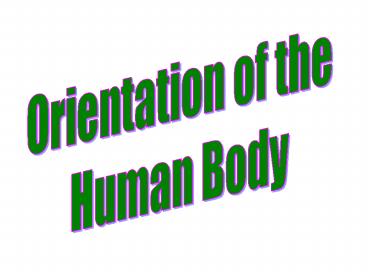Orientation of the - PowerPoint PPT Presentation
1 / 46
Title:
Orientation of the
Description:
There are twelve body systems Skeletal Bones Ligaments joints There are twelve body systems Muscular Skeletal muscle and tendons Cardiac muscle Smooth muscle There ... – PowerPoint PPT presentation
Number of Views:807
Avg rating:3.0/5.0
Title: Orientation of the
1
Orientation of the Human Body
2
Anatomy Study of the structures of the human
body. Concrete Kinesthetic Learning Can be
learned from preserved specimens Vocabulary
repetitive
3
Physiology Study of how the structures of the
body operate to sustain life. Abstract Process
learning Must be studied on living organisms.
(simulations) Often focuses on cellular
or molecular level.
4
Different levels of anatomy Gross large
structures visible to the naked eye
Microscopic small structures visible with
aid of magnification
(cytologycells) (histology tissues)
5
Developmental study how structures change
throughout the lifespan of an
organism. Embryology Changes before
birth often affect later life
6
Anatomy and physiology should be studied hand in
hand because of the Principle of
Complementarity of Structure and function.
7
What a structure does depends In large part on
its form. (how it looks)
8
The six levels of structural organization
9
Level one Molecular level (chemical)
10
Level two Cellular level
11
Level three Tissue level
12
Level fourOrgan level
13
Level five Organ system
level
14
Level six Organism Level
15
(No Transcript)
16
There are twelve body systems
- Skeletal
- Bones
- Ligaments
- joints
17
There are twelve bodysystems
- Muscular
- Skeletal muscle
- and tendons
- Cardiac muscle
- Smooth muscle
18
There are twelve body systems
- Cardiovascular
- Heart
- Arteries
- Veins
- Capillaries
19
There are twelve body systems
- Lymphatic
- Vessels assisting veins
- Lymph nodes
20
There are twelve body systems
- Nervous
- Brain
- Spinal cord
- Nerves
21
There are twelve body systems
- Endocrine
- Glands that
secrete hormones
22
There are twelve body systems
- Integumenty
- in-tegu-mentar-e
- Skin and associated
- structures
23
There are twelve body systems
- Respiratory
- Nose
- Larynx
- Trachea
- Lungs
24
There are twelve body systems
- Digestive
- Alimentary Canal
- Associated glands
- Liver
- Pancreas
- salivary
25
There are twelve body systems
- Urinary
- Kidneys
- Ureters
- Bladder
26
There are twelve body systems
- Immune
- Thymus
- Bone marrow
- Spleen
- Lymph nodes
- Tonsils
- Immune related cells
throughout body
27
There are twelve body systems
- Reproductive
- Male organs
- Female organs
28
Many times there are Interrelationships
among The body systems. No individual organ
system works in isolation!!! For example
29
- Nutrients and oxygen
- are distributed by the
- blood
- Metabolic wastes are
- eliminated by the
- urinary and respiratory
- systems
30
Body Planes
31
(No Transcript)
32
Eight necessary life functions
33
Maintaining boundaries
there are boundaries between cells and
interstitial fluid there are boundaries
between internal body areas and the
environment. alimentary canal skin
surface at alveoli of lung
34
Movement
involves muscular and skeletal systems
may involve actually transporting structures
of the body from one place to another may
involve propelling foreign substances
throughout the body
35
Responsiveness
involves the ability to sense changes in the
environment and respond to those changes
also called irritability nerve cells are the
most irritable other cells can react to
changes also
36
Digestion
breakdown of foodstuff so it can be
absorbed by blood involves physical and
chemical reactions
37
Metabolism
describes all chemical reactions that occur
inside cells. breakdown reactions catabolism
synthesizing reactions anabolism
involves many systems (digestion,
respiration, endocrine)
38
Excretion
elimination of waste material several systems
are involved digestive respiratory
renal
39
Reproduction
at cellular level growth, repair at
organism level whole new
organism closely related to
endocrine system
40
Growth
body parts or whole organism increases in
size constructive activities proceed faster
than destructive ones
41
Five basic Survival Requirements
42
Nutrients from plants carbohydrates
vitamins minerals from animals
proteins fats
43
Oxygen 20 of the air is oxygen
needed to release energy (cellular respiration)
44
Water 60-80 of body weight basic
environment for chemical reactions
transport medium (blood, urine, sweat)
45
Temperature below 37 o C all
body processes slow down too much
above 37oC proteins become
denatured
Too cold
Too hot
46
Atmospheric Pressure air exerts 15
pounds/in2 all over the body needed for
breathing and gas exchange































